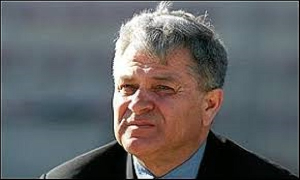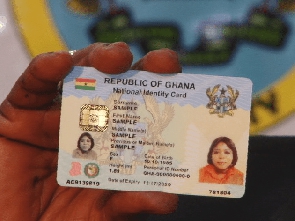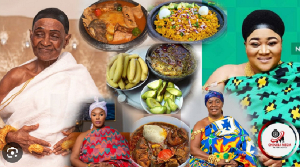Opinions of Wednesday, 30 October 2013
Columnist: Kwarteng, Francis
A Great Ghanaian Scientist -Dr. Victor Lawrence -PartII
A Great Ghanaian Scientist In The Person of Dr. Victor Lawrence—Part ll
Let’s begin from where we left off the last time: The anthropological politics of African history. Part l attempted to make a case for the apparent lack of revolutionary thinking in the fields of science, technology, and mathematics as far as our indigenous educational institutions are concerned. We also attempted to give an epistemological account, though briefly, of the historical intellectuality of ancient Africa, to try to demonstrate that there must be a link, an intellectual continuum, between the intellectual “then” and the intellectual “now.” Besides, in the prequel, as well as, in this essay, we shall rely on the creativity of Dr. Victor Lawrence, as a backdrop, to advance our arguments.
Where exactly do we begin? Let’s start from somewhere, maybe, with Martin Bernal. In fact, to those European scholars we briefly talked about in the prequel, the word, “Abyssinia,” lacked anthropological convolutions of racial overtones. Bernal further writes: “In the second half of the 18th century, however, there were also tendencies to pull the Egyptians back to Africa, tendencies linked to an enthusiasm for Ethiopia reflected in Dr. Johnson’s translation of the 17th-century travels of Father Lobo in that country and his novel ‘Rasselas.’ Although the medieval legend of the Kingdom of Prester John, Europe’s Christian ally beyond Islam, had been applied to various regions of Asia and Africa, Ethiopia as an exotic, remote mountain and Christian kingdom was an admirable candidate. Furthermore, Ethiopia could very plausibly be linked to Ancient Egypt.”
What has this long quote got to do with anything? Everything we have said so far. Bernal adds: “It should, however, be made clear that the name “Abyssinia” was used precisely to avoid “Ethiopia,” with its indelible associations with blackness. The first American edition of Johnson’s work, published in Philadelphia in 1768, was entitled “The History of Rasselas Prince of Abissinia: An Asiatic Tale! Baron Cuvier equated Ethiopia with Negro, but categorized the Abyssinians, as Arabian colonies, as Caucasians.”
Finally, Martin Bernal gives us something to conclude the first part of our arguments: “The great Scottish explorer James Bruce, who was inspired by the vision of Abyssinia/Ethiopia and the quest for the sources of the Nile, learnt better. For him the inhabitants of the Ethiopian mountains were black and, on the whole, beautiful. His fascinating discoveries encouraged admirers of Egypt like Bruce himself, the travellor and savant the Comte de Volney, Dupuis and Champollion to stress the importance of Upper Egypt or even Ethiopia as the sources of Egyptian civilization (See Bernal’s “Black Athena: The Fabrication of Ancient Greece: 1785-1985” for all the quotes).”
Question: Need we be reminded of our beauty? In the meantime, we thought we were done until Bernal gave us another surprise. Who is F.C. Volney (1757-1820)? What did he have to say about us? In fact, Volney made the following remarks about Ancient Black Egypt, about the Sphinx: “All the Egyptians have a bloated face, puffed-up eyes, flat nose, thick lips, in a word, the true face of the mulatto. I was tempted to attribute it to the climate, but when I visited the Sphinx, its appearance gave me the key to the riddle. On seeing the head, typically Negro in all its features, I remembered the remarkable passage where Herodotus says: ‘As for me, I judge the Colchians to be a colony of the Egyptians because, like them, they are black with woolly hair… (See Volney’s “The Ruins of Empires”).
Quite interestingly, Volney visually confirms what Diop confirmed with his “melanin dosage” test. But Volney does have observational corroboration in the person of Vivant Denon (1747-1825). He, too, like Volney, had this to say about Ancient Black Egypt, about the Sphinx: “Though its proportions are colossal, the outline is pure and graceful; the expression of the head is mild, gracious, and tranquil; the character is African, but the mouth, and lips of which are thick… (See Joel A. Freeman’s “The Nose, Lips, Gender & Ethnicity of the Sphinx of Giza: A Truthcentric Perspective”).
Was it not Herodotus, who, in his “History,” Book ll, reported that the Ethiopians said the Egyptians were but a colony of Ethiopians? Was it not Homer who said in “Iliad,” the oldest Greek text, that Greek gods frequented ancient Ethiopia? Why not the other way around? Doesn’t the Egyptologist Anthony T. Browder use his book “Nile Valley Civilization (Exploding the Myths)” to show how Phoenician and Hebrew alphabets, to name just two, evolve from Egyptian hieroglyphics? Why did Prophet Muhammad refer to Ethiopia as a sacred or holy land? Are these not interesting facts? If indeed they are and factually true, why has the West been trying for the past three hundred years or so to wrestle the creative blackness of Ancient Egypt from Africa?
In the meantime, what can we say of the ancient University of Timbuktu where Africans met to discuss women rights while we practice female genital mutilation and trokosi today? Or about the Dogon who knew about Sirius B before the advent of powerful telescopes while we ration electricity today? Or about Timbuktu’s pre-eminent scholar, Ahmad Baba, the same man who authored 40 books in ancient Mali? Why must ancient West African civilizations tolerantly accommodate “minorities” while we intolerantly kill each other today because of Eurocentric tribalism?
Interestingly, Dr. Charles Finch has also demonstrated the advanced nature of ancient African medical knowledge in “Echoes of the Old Darkland,” closely examining the Edwin Smith Papyrus. Indeed, Hippocrates, the so-called Father of Medicine, studied in Egypt under Egyptian professor-priests. Moreover, the so-called Hippocratic Oath idolizes Imhotep whom the Greeks renamed Aesculapius. So why is the Oath not called Imhotepian Oath, say? Finally, Ivan Van Sertima’s “Blacks in Science: Ancient and Modern,” Richard Gillings’ “Mathematics in the Time of the Pharaohs,” and Claudia Zaslavsky’s “African Counts: Number and Pattern in African Cultures,” all show that African has never been starved of mathematical prowess. So, how do we account for falling behind others in these areas?
What explains the huge creative mismatch between the African intellectual past and the African intellectual present? Let’s give a caveat here: We are not romanticizing the African past by resorting to Ancient Egypt. We are, in fact, following the Diopian assertion that ancient Nubia and Egypt must play the same transformative role in the intellectual renaissance of Africa as Rome and Greece has done for the West. Again, does language probably form part of the creative scaffolding of the great mismatch? Could our students be having problems with English, French, Arabic, Dutch, and Portuguese? Are Africans not as linguistically fluid and competent as they are the most genetically diverse in the universe? If this question assertively proves anything, then what is the problem?
Did the African Union not propose of one these, Arabic, Swahili, English, French, as a continental language? What has happened since then? In fact, the invention of scripts, logograms, and pictographs are not ideational novelties in Africa, both in ancient Africa and in the relative present. The Ge’ez script of ancient Ethiopia is probably more than 2000 years, as, Dr. Ayele Bekerie, Asante’s former student and professor at Cornell University, argues in his book “Ethiopic an African Writing System: Its History and Principles.”
We also have the Vai script of Liberia; the Meroitic script of the Nile Valley, a system which UNESCO convened an international consortium of scholars, in 1974, to decipher (See Cheikh Anta Diop’s “The Peopling of Ancient Egypt and the Deciphering of the Meroitic Script.” However, the group of scholars tasked with the responsibility failed to achieve any meaningful results because of the apparent absence of a Rosetta Stone-like linguistic intermediary at the symposium, somewhat like the translational tool which François Champollion used for the transliteration/transcription of ancient Egyptian into Greece).
In addition, we also have the Osmanya script (Somalia), the Tifinagh (Sahara, Sahel, Maghreb), the Mwangwego alphabet (Malawi), the Bakri Sapalo’s script (Oromo, Ethiopia), Mandombe (Congo), Nsibidi (Southeastern Nigeria), and a few others. Cameroon’s King Njoya invented the Banum script but French colonialism placed a moratorium on its usage. It’s been revived over the years. If European languages are creating problems for our students, have we explored alternative pedagogical communication avenues?
On the other hand, Ngugi wa Thiong’o has made powerful arguments similar to Diop’s, asking if our literature should not be called simply African literature in English (and French), not African literature, since most written works in Africa are hardly written in native languages (See “Decolonizing the Mind: The Politics of Language in African Literature”)! Thiong’o’s position is why he has become bilingual, Kikuyu and English, even admitting to NPR’s Terry Gross that more Kenyans read his works now because he writes in Kikuyu as well as in English.
Plus, the Ivorian scholar, G. Niangora-Bouah, has also demonstrated how Akans used gold weights for communication, trade, and other such psychosocial activities (See “Akan World of Gold Weights: Abstract Design Weights”). Technically, these facts go to show that Africa has never been starved of linguistic orthographies, historical and contemporary! Are we exploring them in addition to the foreign ones?
In that case, could we use any of these indigenized tools for pedagogical communication purposes when the Mamprusi, Ga, Twi, Dagomba, or Ewe child, say, has difficulties with English? There were so much the ancients did for themselves to circumvent linguistic barriers. For instance, Harvard University’s Henry Louis Gates, Jr. wept when he visited the University of Timbuktu during his televised series, “Wonders of the African World.” And the reasons for his provoked flow of tears are not farfetched!
At the university he saw ancient manuscripts written in native African languages. He wept because he had been told all his life by White America and Europe that Africa did not have written scripts. However, Asante even goes further than Gates. Asante argues in “The History of Africa: The Quest for Eternal Harmony” that the ancient manuscripts gathered at the University of Timbuktu were not written in Arabic per se, but that the linguistic Arabization of African and others’ ideas in ancient Mali came about because some of the African languages of the manuscripts of ancient Mali borrowed the Arabic script. In that sense, Asante’s arguments are similar to the Anglicization and Frenchification of our indigenized Bibles, as in Twi or Ewe Bible. Is the Twi Bible or Ewe Bible English?
In fact, the possible problem of language, English or French, as a pedagogical tool in our Ghanaian or African context may be likened to the ongoing debate In America, whether Ebonics or English should be used to teach African American children. It has been shown that many African American children do well or better in school with Ebonics than with English. However, the sociological data on this claim is interpretively controversial. Is Ebonics African or English? It depends on who you ask!
But Asante and Mazama have shown quite persuasively in “Speaking My Mother’s Tongue” that Ebonics is indeed an alphabetically Anglicized communication medium erected on foundational rules of African languages! That end the conversation. Further, Asante’s and Mazama’s “Pedagogical Knowledge” are equally useful for our Ghanaian teachers. Dr. Amos Wilson’s “The Developmental Psychology of the Black Child” and “Awakening the Natural Genius of Black Children” both contain useful information for our teachers.
It’s public knowledge that Ghanaian educational system places too much emphasis on English. We, however, acknowledge the prohibitive social, political, cultural, and economic costs we may incur if we decide to replace English with our native tongues in the classroom. Yet it’s a progressive alternative we should explore. Of course, we must teach our students to read well in whatever linguistic medium we use. We must teach them critical reading. Our teachers may use native languages if that makes knowledge transmission less of a problem for students.
Our science and technology departments must emphasize critical reading and not leave that responsibility solely to the humanities/liberal arts, for there appears to be a strong correlation between critical reading and critical thinking, as there is possibly between the humanities/liberal arts and the development of critical thinking skills required of the natural sciences. Back to one of our earlier questions: What could possibly be the creative link between our pre-university and university institutions? Let’s explore the language issue.
Then again, have we given serious thought to Howard Gardner’s “Frames of Mind: Theory of Multiple Intelligences”? What are “multiple intelligences,” anyway? In unadorned language, “multiple intelligences” mean that creativity or ingenuity does not arise exclusively from book learning alone, specifically mathematics and sciences. Athleticism, musicality, theatrics, terpsichorean, pugilism, for instance, are variables of human intelligence. Gardner identifies the following as part of his schemata of his theory: Logical and Mathematical Intelligence; Bodily-Kinesthetic Intelligence; Linguistic Intelligence; Interpersonal Intelligence; Spatial Intelligence; and Musical Intelligence. In this context, Abedi Pele or Diego Maradona is as “intelligent” as Bob Marley, Prof. Allotey, Ama Ata Aidoo, Pablo Picasso, MC Hammer, Ben Carson, Usain Bolt, Charlie Chaplain, and Azumah Nelson.
How about physical infrastructure, classrooms, say? “If we want more students to thrive, we will have to restructure classrooms and schools to create environments where children believe that, if they try, they can learn (See John Bruer’s “Schools for Thought,” p. 258). This is very important. Also, the Indian mathematician, Dr. Chandra Kant Raju, the 2010 Telesio-Galilei Academy of Science Award winner, our friend via Dr. Molefi Kete Asante, author of “Euclid and Jesus,” believes “the new mathematics” should place emphasis on calculation rather than on proof. Raju is presently carrying out an experiment with Malaysian as well as Indian students vis-à-vis his “new mathematics.”
More importantly, Raju forcefully argues in “Euclid and Jesus” that the attribution of the “Elements” to the non-existent Greek, Euclid, is problematically misplaced. He, therefore, makes a strong case for the ancient Black Egyptian, Hypatia, the first documented woman mathematician, as the most probable author of the “Elements” (See also his essay “Towards Equity in Mathematics Education l: Good-Bye Euclid!”). This brings us to the question of girl/woman education. That invariably leads us to the questions of trokosi and female genital mutilation. There is no way trokosi could have produced the likes of Ama Mazama, Madam Curie, Hypatia, Ama Ata Aidoo, Yaa Asantewaa, Miriam Makeba, Queen Nzingha, Winnie Mandela, Toni Morrison, and Taiya Selasi.
Further, the hands-on approach adopted by the Ghana Robotics Academy Foundation, founded by Dr. Ashitey Trebi-Ollenu, is in order. We may also have to study as well as to replicate South Africa’s African Institute of Mathematics, Senegal’s African Center for Teaching Mathematics, Fred Swaniker’s African Leadership Academy, Patrick Awuah, Jr.’s Ashesi University, and New York’s Ross Institute. The latter has been experimenting with Gardner’s “multiple intelligences” for some time now. Another caveat, however: We may not want to uncritically adapt the afore-cited suggestions to our Ghanaian situation because of societal peculiarities and marked variances in culture, child rearing and teacher training methods, pedagogical styles, social and economic structures, teacher remuneration, national politics, jurisprudential politics, national wealth, and children rights.
Having said all that, Dr Molefi Kete Asante seems to notice something else which all the authorities we have relied on seem to have missed. We therefore give Asante the opportunity to give us the last word: “Such a curriculum structured on the basis of the best practices of African philosophy will change the reality of education…Clearly this situation calls for Afrocentric education that can transform the lives of African people. A revolution in the educational system will mean that from kindergarten through graduate school the institutions of Africa must be changed to conform to the interests and necessities of the African condition.”
Dr. Asante concludes: “This can be done but will not be done until educators are determined to control their own destinies…Universities in Africa must organize themselves in ways that preserve the best of the African ancestral traditions while opening the door to ideas from the rest of the world…It’s this intellectual plinth that will provide the base for a new construction toward a real African renaissance (See Asante’s “The Philosophical Bases for an African University: Designing Afrocentric Curricula for African Universities,” “Decolonizing Our Universities,” Penang, Malaysia, 2011). Granted, can we, Ghana and Africa, make a useful intellectual link between the African past and the African present? Yes, we believe we can? How? Look at Egypt’s Imhotep and Ghana’s Dr. Victor Lawrence!
The end.












